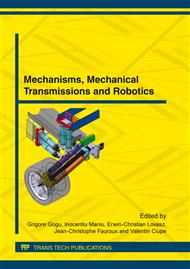[1]
J.C. Fauroux, J. Dakhlallah, B.C. Bouzgarrou, A New Concept of FAST Mobile Rover with Improved Stability on Rough Terrain, in Proc. of HUDEM'2010, 8th International Advanced Robotics Programme (IARP) Workshop on Robotics and Mechanical assistance in Humanitarian De-mining and Similar risky interventions, 10-12 May, 2010, Nat. Eng. School of Sousse, Tunisia. Paper #26, 16 p. Downloadable on http: /jc. fauroux. free. fr.
Google Scholar
[2]
D. Hurst, Sandia hopping robots to bolster troop capabilities, Sandia Labs News Releases, 11-Sep-2009. [Online]. Available: http: /goo. gl/YuzlO.
Google Scholar
[3]
M. Hoffman, Jumping robot to get tested in Afghanistan, ArmyTimes, 07-Nov-2011. [Online]. Available: http: /goo. gl/gvhCt.
Google Scholar
[4]
M. Davis, C. Gouinaud, J. C. Fauroux, and P. Vaslin, A Review of Self-Righting Techniques for Terrestrial Animals, in International workshop on bio-inspired robots, Ecole des Mines and IRCCYN LAB, Nantes, (2011).
Google Scholar
[5]
E. Chang-Siu, T. Libby, M. Tomizuka, and others, A lizard-inspired active tail enables rapid maneuvers and dynamic stabilization in a terrestrial robot, in Intelligent Robots and Systems (IROS), 2011 IEEE/RSJ International Conference, 2011, p.1887.
DOI: 10.1109/iros.2011.6094658
Google Scholar
[6]
A. Jusufi, D. I. Goldman, S. Revzen, and R. J. Full, Active tails enhance arboreal acrobatics in geckos, Proceedings of the National Academy of Sciences, vol. 105, no. 11, pp.4215-4219, Mar. (2008).
DOI: 10.1073/pnas.0711944105
Google Scholar
[7]
C. Kaplan, LEO satellites: attitude determination and control components; some linear attitude control techniques, Master of Science in Electrical and Electronics Engineering Thesis, Middle East Technical University, (2006).
Google Scholar
[8]
P. Vaslin, V. Pouzols, C. Gouinaud, J. -C. Fauroux, S. Deleplanque, and M. Davis, Contrôle du tangage d'un véhicule en phase balistique, in 20ème Congrès Français de Mécanique, Besançon, (2011).
Google Scholar
[9]
AOS Technologies AG, S-MOTION High Speed Camera Technical Specifications. [Online]. Available: http: /goo. gl/P3qJX.
Google Scholar
[10]
V. Pouzols, Modélisation des facteurs influençant la trajectoire aérienne du système {pilote + moto} lors d'un saut en moto-cross. Validation expérimentale du modèle, Master of Science in Mechanics, Université Blaise Pascal, Clermont-Ferrand, (2006).
Google Scholar
[11]
Mouvement Français pour la Qualité, Guide pour la détermination des incertitudes de mesure, MFQ Franche Compté, Besançon, (1995).
Google Scholar
[12]
J. J. Dowling, J. L. Durkin, and D. M. Andrews, The uncertainty of the pendulum method for the determination of the moment of inertia, Medical engineering & physics, vol. 28, no. 8, p.837–841, (2006).
DOI: 10.1016/j.medengphy.2005.11.007
Google Scholar


